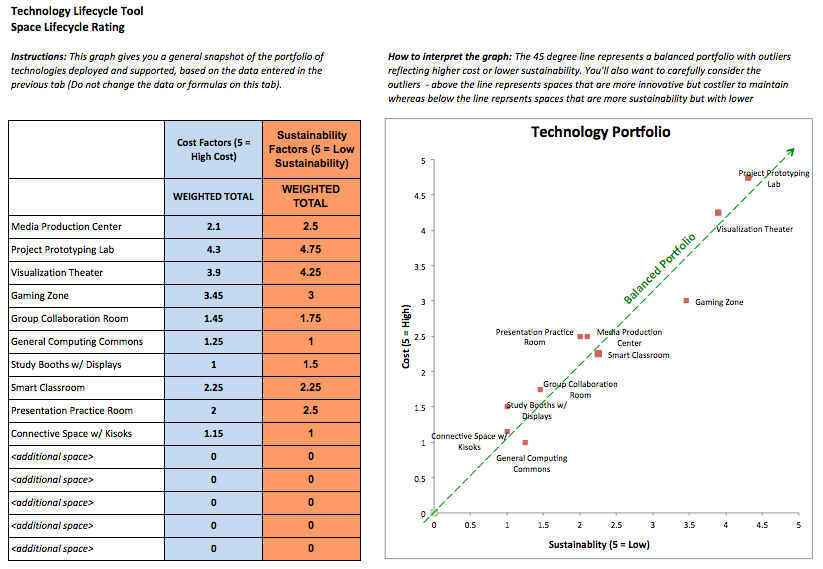Life-Cycle Strategies
This tool helps you think through these and rate seven factors for each of your spaces, provides a suggested weighting of these factors, and provides a graph to visualize these cost and sustainability factors to give you a snapshot of your technology lifecycle – how well you’re balancing initial cost with the total cost of ownership. For the sake of argument, we will take four years as our standard period to think of for calculating life cycle cost. The actual life cycle of an individual piece of equipment can vary anywhere from 2 years to 7 years depending on whether we are talking about mobile devices or network switches, but 4 years is a good medium for overall lifecycle planning and calculations. A four year period allows us to represent the majority of costs fairly by looking at the middle of the lifecycle bell curve, with the short-life and long-life equipment tapering out on the edges of the curve.
Life-cycle Cost factors to consider
| Annual Maintenance / Ops Costs | Direct cost for hardware and software maintenance for a particular piece of equipment and the applications that reside on it. The least costly type of maintenance is generally to bundle it with the purchase of the hardware or software since contract rates are usually low at the time of initial purchase. Middle cost is to pay for maintenance contracts year by year. Generally, the most costly model is to have no maintenance contracts and pay for service on an a la cart basis per service call (“when something breaks”) since most manufacturers charge a premium for this kind of service. |
| Refresh Costs | Low cost refresh for equipment has a refresh lifecycle upwards of 7 years, such as network switches. Middle of the road is 4 year refresh, such as for desktop computers. Medium-high cost items are usually gadgets like cameras, iPods, etc for lending that last about two years. High cost items are refreshed every year, generally “consumables” like USB drives, headphones, laptop power adapters, etc. |
| Innovation Costs | In contrast to Refresh Cost, which replaces a piece of equipment when it reaches a point of natural decline in usefulness or functionality, Innovation Cost upgrades equipment as soon as the latest and greatest version comes out. The most expensive Innovation Cost comes when the latest new-release experimental gadgets and equipment are bought as soon as they hit the market. Innovation Cost roughly maps to the Levels of Technology [link to Technology Design Process, where there should be a table with this] definitions (basic, enhanced, advanced, experimental). |
| Staffing Costs | Represents the level of staff expertise generally needed to support a space, scaling from use (Level 1 staff), to fix (Level 2), to consult (Level 3), to customize (Level 2 and 3), to develop (Level 2, 3, and 4). These levels of staff can be found on the Staffing-Services page. |
Life-cycle Sustainability factors to consider
| Efficiency | Efficiency defines sustainability as a measure of the manufacturing, materials, packaging/shipping distance, recycling, and energy use for a particular type of equipment. Often this is defined with government or industry standards, such as EPEAT and Energy Star for computing equipment. To rate a space, take the average of the ratings for all the equipment in the room. Highly sustainable technology has the best ratings in all categories; low sustainability technology tends to have high energy consumption for its class, lots of excessive packaging, non-recyclable materials, etc. |
| Maturity | Maturity factors include the extent and “freshness” of the user community, the depth of vendor support network, and length of maintenance history. Mature technologies have large user communities; many companies or many people who can provide knowledgeable support, as opposed to “just that one guy”; and a long maintenance track record with regular upgrade releases that have ironed out bugs. |
| Build or Buy | Build or Buy is a classic sustainability question that balances the drive for innovation (build products that aren’t yet available on the market) versus buy (acquire technologies that have a viable product on the market). A balanced portfolio combines reasonable elements of both built and bought technology. Conservative portfolios have only bought technologies in order to contain the staff cost of supporting built technology. Bleeding edge innovation environments tend to build their own technologies even when viable alternatives exist on the market, generally because of a desire for specific functionality or highly customized local requirements that don’t exist in the market products. |
Tool
Life-Cycle Tool – Downloadable Tool for your use (MS Excel).

